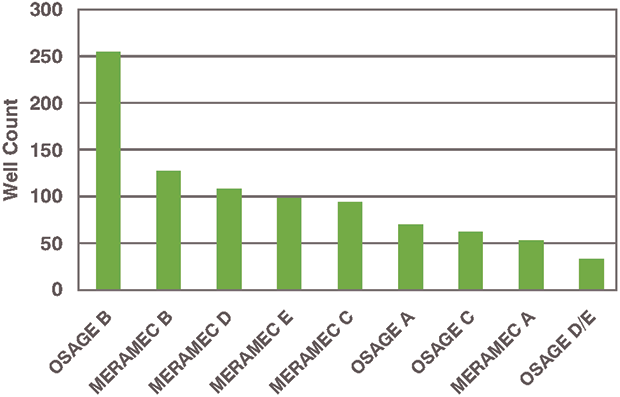
Anadarko Basin
Study Finds Huge Oil And Gas Reserves Upside
HOUSTON–Unconventional reservoirs in the Greater Anadarko Basin hold an estimated 16 billion barrels of oil and more than 200 trillion cubic feet of natural gas in unrisked technically recoverable resources, according to a new report from IHS Markit.
Notably, the company points out that the 200 Tcf gas estimate does not include significant volumes of known recoverable unconventional resources in the basin’s Granite Wash trend. The research also identified what the study’s co-authors call potentially “one of the biggest yet-to-be developed shale plays in the United States.”
“The Anadarko Basin has long been a major contributor to U.S. production, but it is just getting started in terms of delivering on its unconventional production potential,” says John Roberts, executive director, global subsurface operations, at IHS Markit, “We are now witnessing a new kind of Oklahoma land rush. But unlike what happened in 1889 when lands were opened to settlement, this time the competition is for access to the energy resources that lie below the surface.”
Centered in western Oklahoma, the Anadarko Basin covers 50,000 square miles across the Sooner State and extending into the Texas Panhandle and southwestern Kansas. A prolific source of conventional oil and gas production since the 1950s, oil and gas fields within the basin include the Hugoton Gas Field, West Edmond Field, Union City Field and Elk City Field.
Roberts remarks that the IHS Markit analysis shows the basin pushing toward new all-time production highs long after conventional oil and gas production peaked in the 1970s and 1980s, respectively. Horizontal drilling in the Anadarko Basin has increased sharply in recent years, and annual basin production volumes have already set new peak records, he points out.
Following an earlier study of the Permian Basin, which estimated 60 billion-70 billion barrels of technically recoverable resources in 52 (11 continuous shale and 41 stratigraphic/structural) plays, the Anadarko Basin analysis comes from the first phase of a comprehensive study to model and interpret the basin’s key geologic characteristics–including 3-D geologic models of 41 plays–to better estimate its remaining hydrocarbon potential, the study explains.
Noting that the findings significantly alter understanding of the Anadarko’s remaining resource potential, Roberts says the analysis provides significant advances in the accuracy and granularity of detailed producing-formation information that is historically difficult to acquire.
“By getting to a greater level of granularity and accuracy regarding producing formations, we change the entire view of the basin,” comments Roberts, who co-authored the research along with Prithiraj Chungkham, IHS Markit’s director of unconventional resources. “For geologists, it is like having a more powerful microscope.”
Simpson Surprise
Among the most surprising results was the vast potential of the Simpson Shale. Roberts says IHS Markit believes the Simpson formation could be one of the largest remaining undeveloped U.S. resource plays.
“The Simpson has long been among the largest historical producers of vertical production in the Anadarko Basin,” Roberts offers. “But our new analysis shows that there is also significant Simpson potential as a major driver for horizontal shale production.”
The analysis utilizes the IHS Markit historical well and production database, which incorporates more than 320,000 wells. It also includes the new proprietary PRODFit™ tool for leveraging interpreted formation “tops” data for the first time, Roberts relates, enabling the accurate identification of the formation completion intervals on 275,000 wells (Figure 1). The data was then modeled and interpreted using IHS Kingdom™ geology and geophysics software, he details.
The modeled and interpreted formations and benches in the STACK and SCOOP plays are delivered in a workstation-ready 3-D format. The significant improvement in assigned formations not only adds detail and accuracy to the interpretive process, but dramatically changes the views of the basin and understanding of where future hydrocarbon potential exists, Roberts adds.
“As it stands now, only about 20 percent of the Anadarko’s STACK sweet spot locations have been drilled or developed,” he states. “The play is still in its early stages of unconventional development. We can easily envision an additional 4,000-5,000 horizontal wells drilled.”
Overall, the study’s results underscore the basin’s renewed attractiveness, observes Chungkham. “The Anadarko is attractive because it has 41 stacked plays, which overlap in many parts of the basin,” he says. “For operators, that means multiple targets that can be accessed from one well pad.”
For more information on the study, titled "IHS Markit Complete Play Analysis of the Greater Anadarko Basin, Texas, Oklahoma and Kansas, USA," visit the IHS Markit website.
For other great articles about exploration, drilling, completions and production, subscribe to The American Oil & Gas Reporter and bookmark www.aogr.com.







